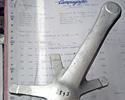

A Cyclingnews special sponsorship feature
Virtual Visit: Campagnolo, Vicenza, Italy
By Cyclingnews staff
What goes on behind the doors of one of the world's top two bicycle component manufacturers? Tim Maloney takes a tour of Campagnolo's factory and finds out how the legendary Italian company goes from raw materials to finished parts.
 |
Bicycle component maker Campagnolo does not allow the public to tour its factory, but during the last Giro d'Italia, Cyclingnews visited the Vicenza, Italy firm and came away with this exclusive Virtual Visit for our readers.
In 1933, Italian racer Tullio Campagnolo decided to patent two ideas he came with through his cycling experience. The first patent was for an innovative quick release system for the bicycle wheel, while his second patent was for a rod-controlled front derailleur system. Campagnolo's creations were intended for road racing bikes and were highly sought after by the day's top riders.
Seven years later, Tullio Campagnolo hired his first employee to keep up with the demand for his parts. Up until that time, Campagnolo would make the bike parts himself in his family's metalworking business and sell them himself. Although World War Two slowed things down, it didn't stop Tullio from working on more innovative ideas for bicycle components. In 1949, Campagnolo unveiled his new design for a parallogram rear derailleur with springs; a sleek, smooth-shifting gear change that immediately became first in class among bicycle shifting systems.
 |
Besides improving on his original designs with the legendary Campagnolo Record and Super Record groups, in the years from 1950 to 1980, Tullio Campagnolo worked on other projects. Among them was the legendary Campagnolo corkscrew, as well as working with lightweight aluminium alloy and magnesium for NASA, for use in the construction of the Apollo space module. Campagnolo also developed helicopter rotors and a unique braking system used by GP motorcyclists Walter Villa and Johnny Cecotto to win GP's and World Championships. Nonetheless, the core business at Campagnolo continued to be the bicycle sector.
In 1981, Campagnolo moved from its original home at Corso Padova, 101 in Vicenza to a new, purpose-built factory in the industrial zone near the autostrada. In 1983, Tullio Campagnolo passed away and his only son, Valentino took over management of Campagnolo Spa. After some dabbling in the mountain bike arena in the late '80s and early '90s, Campagnolo decided to focus 100 percent on its core business of components for road racing bikes.
 |
With a judicious application of high technology and years of expertise in the bicycle component market, Campagnolo has re-established itself as not only a viable alternative but also as a solid competitor to the giant Japanese bicycle component firm Shimano. Currently Campagnolo sells 33 per cent of its turnover at home in Italy and via commercial subsidiaries (in France, Spain, Germany and the USA) and agents (in Benelux, Denmark, Sweden, England, Australia, Russia, South America and Eastern Europe).
Seventy years after Tullio Campagnolo developed his first innovative products, road cyclists the world over consider Campagnolo the ultimate in bicycle componentry.
Photos
Images by Tim Maloney/Cyclingnews.com
- I wonder what this place is
- This loading dock is where Campagnolo receives and checks the wide variety of raw materials they use to create their products
- These raw aluminium billets will be transformed into the high quality parts Campagnolo is famous for.
- Note the sprocket spacer shaped bars awaiting cutting.
- Once the raw materials are checked for quality and spec, Campagnolo sends it out to a foundry to be cast.
- Here is a rack of Campagnolo cranks before and after the machining process.
- The machining process is complete and now cranks are ready for final polishing
- Here some cranks go through a final polishing process after machining.
- This test machine on the factory floor ensures that all Campagnolo parts are being produced to the exact tolerances as called for in the specifications, all the time, every time.
- Campagnolo precision stamps from aluminium sheet and then finishes their own sprockets and chainrings to ensure quality control.
- After stamping and finishing, these Campagnolo sprockets are placed on this rack prior to entering the galvanic (anodized) treatment area.
- With the anodization process, one can see the different chemical reactions from each bath.
- Note the different colours in the chemical baths that indicate a chemical reaction taking place.
- Each Campagnolo part that has its name or the Campagnolo logo on it undergoes this unique "tamponografia" process
- Here is an exclusive look into Campagnolo's top-secret test lab.
- Campagnolo uses this special test bed machine to measure real-time force exerted by a rider.
- Another special testing machine at Campagnolo to measure and check Ergopower shift levers.
- Within their warehouse, Campagnolo keeps stock of the 200 small parts with the highest demand
- Here is one part of the vast Campagnolo warehouse in Vicenza